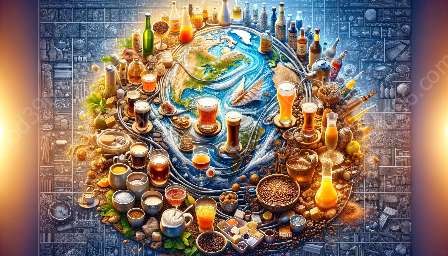Beverages have been an integral part of human culture and societies for centuries, with their consumption patterns evolving alongside global and regional developments. This article delves into the fascinating history and evolution of beverage consumption, exploring its impact on global and regional patterns as well as its significance in beverage studies.
Global and Regional Beverage Consumption: A Brief Overview
Beverage consumption has played a central role in the culinary traditions, social rituals, and economic landscapes of various societies throughout history. The consumption of beverages, ranging from water and tea to alcoholic drinks and carbonated beverages, has been deeply entrenched in cultural practices and traditions, shaping the identities and experiences of different regions around the world.
Early Beverage Consumption: From Ancient Times to the Middle Ages
The history of global and regional beverage consumption can be traced back to ancient civilizations such as Mesopotamia, Egypt, and China, where the cultivation and consumption of beverages like beer, wine, and tea held significant cultural and religious importance. In these early times, beverages were often consumed for their perceived medicinal and spiritual properties, and their production and consumption were intertwined with agricultural practices and trade routes.
During the Middle Ages, the consumption of beverages further evolved, with the emergence of traditional brewing methods, the introduction of new ingredients, and the spread of knowledge and techniques through trade and exploration. This period also witnessed the rise of coffeehouses in the Arab world and later in Europe, which became hubs for intellectual exchange and social interactions, significantly influencing beverage consumption patterns.
Colonial Expansion and Global Trade: Shaping Beverage Consumption
The era of colonial expansion and global trade had a profound impact on global beverage consumption patterns. European powers such as Spain, Portugal, and the Netherlands introduced new beverages to regions around the world, including coffee, cocoa, and various alcoholic drinks. This facilitated the exchange of cultural practices and the integration of new beverages into local traditions, leading to the diversification of global beverage consumption.
Furthermore, the transatlantic slave trade played a significant role in the spread of beverages such as rum and sugarcane-based drinks, which became closely associated with the economies and cultures of the Americas and the Caribbean. The production and consumption of these beverages were shaped by the labor practices and colonial policies of the time, leaving a lasting imprint on regional consumption patterns.
Industrialization and Modernization: Revolutionizing Beverage Production
The advent of industrialization and modernization in the 19th century ushered in a new era of beverage production and consumption. The mechanization of brewing, the development of bottling and packaging technologies, and the mass production of carbonated drinks transformed the beverage industry, leading to the widespread availability and consumption of various beverages on a global scale.
Additionally, the globalization of trade and the emergence of multinational corporations further influenced beverage consumption, as mass-marketed products and branding strategies shaped consumer preferences and purchasing behaviors. This period also witnessed the onset of regulatory measures and public health initiatives aimed at addressing the social and health implications of excessive beverage consumption.
Contemporary Trends and Regional Consumption Patterns
In the modern era, global and regional beverage consumption patterns continue to evolve in response to changing demographics, cultural influences, and economic developments. While traditional beverages maintain their cultural significance and local relevance, there has been a notable surge in the consumption of non-alcoholic and health-oriented beverages, reflecting shifting consumer preferences and concerns about wellness and sustainability.
Moreover, regional variations in beverage consumption have become increasingly pronounced, with the emergence of localized craft breweries, wineries, and artisanal beverage producers contributing to the diversification of the global beverage landscape. This trend reflects a growing appreciation for unique flavors, heritage, and terroir, emphasizing the significance of regional identity and authenticity in beverage consumption.
Impact on Beverage Studies and Future Perspectives
The history and evolution of global and regional beverage consumption have not only shaped cultural and economic landscapes but have also significantly impacted the field of beverage studies. Scholars and researchers in this interdisciplinary field explore the social, historical, and scientific dimensions of beverages, encompassing areas such as anthropology, sociology, agriculture, and gastronomy.
From studying the cultural symbolism of specific beverages to researching the ecological impact of beverage production, beverage studies offer valuable insights into the multifaceted nature of global and regional beverage consumption. Furthermore, the interdisciplinary nature of beverage studies allows for a comprehensive exploration of the complex relationships between beverages and human societies, resulting in a deeper understanding of cultural heritage, trade dynamics, and consumer behaviors.
Conclusion
The history and evolution of global and regional beverage consumption reflect the dynamic interplay between cultural traditions, economic forces, and societal changes. As beverage consumption continues to evolve, it remains an essential component of human experience, influencing global and regional consumption patterns while inspiring research and inquiry in the field of beverage studies.

